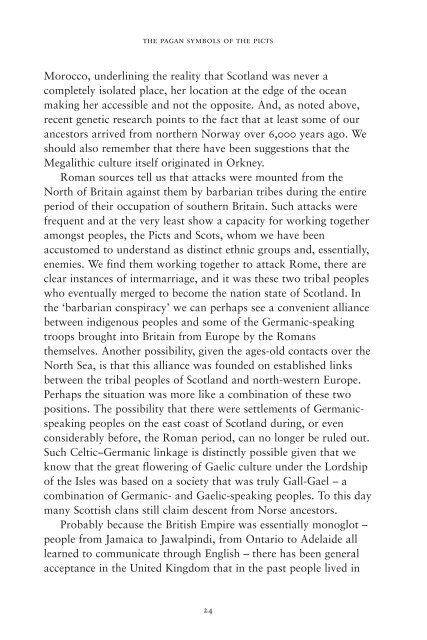Pagan Symbols of the Picts by Stuart McHardy sampler
Stuart McHardy examines the Pictish symbols which have been discovered on various items across Scotland. The book sets out a cohesive interpretation of the Pictish past, using a variety of both temporal and geographical sources. This interpretation serves as a backdrop for his analysis of the symbols themselves, providing a context for his suggestion that there was an underlying series of ideas and beliefs behind the creation of the symbols.
Stuart McHardy examines the Pictish symbols which have been discovered on various items across Scotland. The book sets out a cohesive interpretation of the Pictish past, using a variety of both temporal and geographical sources. This interpretation serves as a backdrop for his analysis of the symbols themselves, providing a context for his suggestion that there was an underlying series of ideas and beliefs behind the creation of the symbols.
Create successful ePaper yourself
Turn your PDF publications into a flip-book with our unique Google optimized e-Paper software.
<strong>the</strong> pagan symbols <strong>of</strong> <strong>the</strong> picts<br />
Morocco, underlining <strong>the</strong> reality that Scotland was never a<br />
completely isolated place, her location at <strong>the</strong> edge <strong>of</strong> <strong>the</strong> ocean<br />
making her accessible and not <strong>the</strong> opposite. And, as noted above,<br />
recent genetic research points to <strong>the</strong> fact that at least some <strong>of</strong> our<br />
ancestors arrived from nor<strong>the</strong>rn Norway over 6,000 years ago. We<br />
should also remember that <strong>the</strong>re have been suggestions that <strong>the</strong><br />
Megalithic culture itself originated in Orkney.<br />
Roman sources tell us that attacks were mounted from <strong>the</strong><br />
North <strong>of</strong> Britain against <strong>the</strong>m <strong>by</strong> barbarian tribes during <strong>the</strong> entire<br />
period <strong>of</strong> <strong>the</strong>ir occupation <strong>of</strong> sou<strong>the</strong>rn Britain. Such attacks were<br />
frequent and at <strong>the</strong> very least show a capacity for working toge<strong>the</strong>r<br />
amongst peoples, <strong>the</strong> <strong>Picts</strong> and Scots, whom we have been<br />
accustomed to understand as distinct ethnic groups and, essentially,<br />
enemies. We find <strong>the</strong>m working toge<strong>the</strong>r to attack Rome, <strong>the</strong>re are<br />
clear instances <strong>of</strong> intermarriage, and it was <strong>the</strong>se two tribal peoples<br />
who eventually merged to become <strong>the</strong> nation state <strong>of</strong> Scotland. In<br />
<strong>the</strong> ‘barbarian conspiracy’ we can perhaps see a convenient alliance<br />
between indigenous peoples and some <strong>of</strong> <strong>the</strong> Germanic-speaking<br />
troops brought into Britain from Europe <strong>by</strong> <strong>the</strong> Romans<br />
<strong>the</strong>mselves. Ano<strong>the</strong>r possibility, given <strong>the</strong> ages-old contacts over <strong>the</strong><br />
North Sea, is that this alliance was founded on established links<br />
between <strong>the</strong> tribal peoples <strong>of</strong> Scotland and north-western Europe.<br />
Perhaps <strong>the</strong> situation was more like a combination <strong>of</strong> <strong>the</strong>se two<br />
positions. The possibility that <strong>the</strong>re were settlements <strong>of</strong> Germanicspeaking<br />
peoples on <strong>the</strong> east coast <strong>of</strong> Scotland during, or even<br />
considerably before, <strong>the</strong> Roman period, can no longer be ruled out.<br />
Such Celtic–Germanic linkage is distinctly possible given that we<br />
know that <strong>the</strong> great flowering <strong>of</strong> Gaelic culture under <strong>the</strong> Lordship<br />
<strong>of</strong> <strong>the</strong> Isles was based on a society that was truly Gall-Gael – a<br />
combination <strong>of</strong> Germanic- and Gaelic-speaking peoples. To this day<br />
many Scottish clans still claim descent from Norse ancestors.<br />
Probably because <strong>the</strong> British Empire was essentially monoglot –<br />
people from Jamaica to Jawalpindi, from Ontario to Adelaide all<br />
learned to communicate through English – <strong>the</strong>re has been general<br />
acceptance in <strong>the</strong> United Kingdom that in <strong>the</strong> past people lived in<br />
24


















